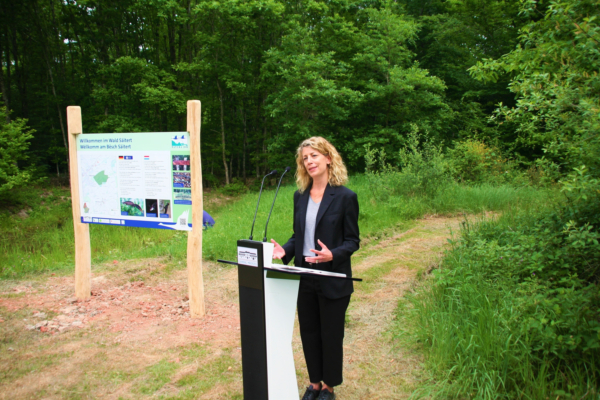 Joëlle Welfring, Minister for the Environment, Climate and Sustainable Development;
Credit: MECDD
Joëlle Welfring, Minister for the Environment, Climate and Sustainable Development;
Credit: MECDD
On Thursday 19 May 2022, Luxembourg's Minister of Environment, Climate and Sustainable Development, Joëlle Welfring, inaugurated the new Natura 2000 area “Massif forêt et mardelles du Säitert – Mertzig” in Mertzig.
The municipality of Mertzig has taken the initiative to propose this 45 hectare area as a Natura 2000 area. In particular, an inclusive educational trail is being developed to introduce everyone to the natural riches of this forest.
The Natura 2000 network in Luxembourg
In recent years, Luxembourg has made many efforts to give even more importance to the protection of nature, with greater emphasis on the designation of Natura 2000 protected areas. The country currently has 48 special areas of conservation and eighteen special protection zones. In total, these areas cover an area of about 27% of the country. With the designation of the Natura 2000 site in Mertzig, Luxembourg will have a total of 67 Natura 2000 areas.
For Natura 2000 sites, management plans have been drawn up, specifying the long-term objectives of the various sites and the way of achieving these objectives through concrete measures. The implementation of the management plans is accompanied by steering committees and regional exchange platforms made up of the various interest groups. The steering committees are accompanied by a facilitator responsible for facilitating and coordinating the implementation of the measures and serving as the first point of contact for the various actors.
Details of the area in Mertzig
It is on the initiative of the municipality of Mertzig that the designation of this Natura 2000 area is proposed, a forest massif rich in old trees and dotted with stagnant water, also called "mardelles". More specifically, two forest habitats protected at European level are present in this forest, namely the beech forests of Luzulo-Fagetum and the beech forests of Asperulo-Fagetum. A third habitat protected at European level is constituted by natural eutrophic water bodies with Magnopotamion or Hydrocharition vegetation. Several rare or threatened species are present; the designation specifically targets the protection of the Great Crested Newt, as well as two species of bats, the Bechstein's Bat and the Greater Bat.
The management measures already applied in the Natura 2000 area are, among other things, the designation of aging islands and biotope trees, the improvement of the forest structure, the development of forest edges and the creation, the conservation and enhancement of existing biotopes, including mardelles in particular.
The general public is welcome
The designation of the site in no way corresponds to a limitation, rather visitors are invited to discover this Natura 2000 area and the biodiversity present there at their own pace. In order to make the particularities of the site accessible to all visitors, an inclusive educational trail in collaboration with the non-profit organisation “OP DER SCHOCK”, a cooperative society which manages services for people with mental disabilities, is being developed, to discover the natural wealth of this forest that is already visible.
What is a Natura 2000 area?
Natura 2000 is a network of protected natural sites at European Union (EU) level, made up of special areas of conservation and special protection areas. Based on two directives, the 1979 Birds Directive and the 1992 Habitats Directive, Natura 2000 aims for the long-term protection and conservation of Europe's most valuable and threatened species and habitats. These protected areas make an important contribution to the protection of biodiversity in the EU and guarantee the preservation of ecosystems for future generations.








